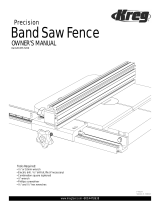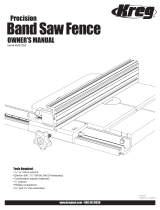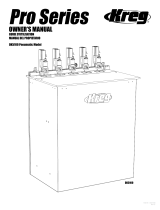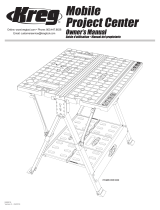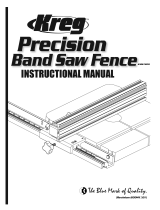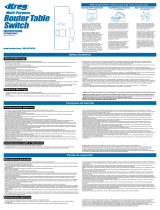Page is loading ...

Miter Gauge System
Precision
OWNER’S MANUAL
GUIDE D’UTILISATION
MANUAL DEL PROPIETARIO
Item# KMS7102
Item# KMS7101
Article #KMS7102
Article #KMS7101
Artículo #KMS7102
Artículo #KMS7101
www.kregtool.com • 800.447.8638
FT4032
Version 4 - 06/2018

Safety Guidelines
WARNING!
!
To reduce the risk of injury, user must read the instruction manual.
WARNING!
!
Read all instructions. Failure to follow all instructions listed below may result in electric shock, re and/or serious injury. The term “power tool” in all of the warnings listed below
refers to your mains-operated (corded) power tool or battery-operated (cordless) power tool.
SAVE THESE INSTRUCTIONS
1) Work area safety
a) Keep work area clean and well lit. Cluttered or dark areas invite accidents.
b) Don’t use power tools in a dangerous environment. Don’t use power tools in damp or wet locations, or expose them to rain.
c) Do not operate power tools in explosive atmospheres, such as in the presence of ammable liquids, gases or dust. Power tools create sparks which may ignite the dust or fumes.
d) Keep children and bystanders away while operating a power tool. Distractions can cause you to lose control.
e) Make your workshop child proof with padlocks, master switches, or by removing starter keys.
2) Electrical safety
a) Power tool plugs must match the outlet. Never modify the plug in any way. Do not use any adapter plugs with earthed (grounded) power tools. Unmodied plugs and matching outlets will reduce risk of electric shock.
b) Ground electric tools. If the tool is equipped with a three-prong plug, it should only be plugged into a grounded three-hole electrical outlet. If the proper outlet is not available, have one installed by a qualied electrician. N
ever remove the third prong or modify the provided plug in any way.
c) Avoid body contact with earthed or grounded surfaces such as pipes, radiators, ranges and refrigerators. There is an increased risk of electric shock if your body is earthed or grounded
d) Do not expose power tools to rain or wet conditions. Water entering a power tool will increase the risk of electric shock.
e) Do not abuse the cord. Never use the cord for carrying, pulling, or unplugging the power tool. Keep cord away from heat, oil, sharp edges, or moving parts. Damaged or entangled cords increase the risk of electric shock.
f) Use a proper extension cord and make sure it is in good condition. When using an extension cord, be sure to use one heavy enough to carry the current your machine draws. An undersized cord causes a drop in line voltage
resulting in loss of power and overheating. When operating a power tool outdoors, use an extension cord suitable for outdoor use.
3) Personal safety
a) Stay alert, watch what you are doing, and use common sense when operating a power tool. Do not use a power tool while you are tired or under the inuence of drugs, alcohol, or medication. Do not allow familiarity
gained from frequent use of a tool to replace safe work practices. A moment of inattention while operating power tools may result in serious personal injury.
b) Always wear safety glasses. Everyday eyeglasses only have impact resistant lenses, they are NOT safety glasses.
c) Use safety equipment. Use a face or dust mask when the cutting operation is dusty. Safety equipment such as a dust mask, non-skid safety shoes, hard hat, or hearing protection used for appropriate conditions reduces personal injuries.
d) Avoid accidental starting. Ensure the switch is in the off-position before plugging in. Carrying power tools with your nger on the switch or plugging in power tools that have the switch on invites accidents.
e) Remove any adjusting key or wrench before turning the power tool on. A wrench or a key left attached to a rotating part of the power tool may result in personal injury.
f) Do not overreach. Keep proper footing and balance at all times. This enables better control of the power tool in unexpected situations.
g) Secure workpieces. Use clamps or a vise to hold work when practical. This is safer than using your hand and it frees both hands to operate the tool.
h) Never stand on the machine. Serious injury could occur if the tool tips or if the cutting tool is unintentionally contacted.
i) Dress properly. Do not wear loose clothing or jewelry. Keep your hair, clothing and gloves away from moving parts. Loose clothes, jewelry or long hair can be caught in moving parts.
j) If devices are provided for the connection of dust extraction and collection facilities, ensure these are connected and properly used. Use of these devices can reduce dust-related hazards.
4) Power tool use and care
a) Keep guards in place, properly adjusted, and in working order.
b) Do not force the power tool. Use the correct power tool for your application. The tool will do the job better and safer at the feed rate for which it was designed.
c) Use the right tool or accessory. Don’t a force tool or attachment to do a job for which it was not designed.
d) Do not use the power tool if the switch does not turn it on and off. Any power tool that cannot be controlled with the switch is dangerous and must be repaired.
e) Disconnect the plug from the power source and/or the battery pack from the power tool before making any adjustments, changing accessories, or storing power tools.
Such preventive safety measures reduce the risk of starting the power tool accidentally.
f) Never leave tool running unattended. Turn power off. Don’t leave tool until it comes to a complete stop.
g) Store idle power tools out of the reach of children and do not allow persons unfamiliar with the power tool or these instructions to operate the power tool. Power tools are dangerous in the hands of untrained users.
h) Maintain power tools. Check for misalignment or binding of moving parts, breakage of parts and any other condition that may affect power tool operation. If damaged, have the power tool repaired before use.
Many accidents are caused by poorly maintained power tools.
i) Keep cutting tools sharp and clean. Properly maintained cutting tools with sharp cutting edges are less likely to bind and are easier to control.
j) Use the recommended speed for the cutting tool or accessory and workpiece material.
k) Only use parts and accessories recommended by the manufacturer. Consult the owner’s manual for recommended accessories. Using improper accessories may cause personal injury.
l) Use the power tool, accessories, bits, and blades in accordance with these instructions and in the manner intended for the particular type of power tool,
taking into account the working conditions and the work to be performed. Use of the power tool for operations different from those intended could result in a hazardous situation.
5)Avoid kickback when operating your power tool. Kickbacks can cause serious injury, property damage, or death.
A kickback usually occurs when the workpiece or cut-off piece binds or becomes trapped between a spinning blade or bit and the machine fence and is violently ejected. To avoid kickback:
a) Always use a sharp blade or bit.
b) On a tablesaw, ensure that both the saw blade and rip fence are parallel to the miter-gauge slots. See your tablesaw owner’s manual for instructions on making these adjustments.
c) Plan your tablesaw cuts to avoid binding. Never use the rip fence and the miter gauge at the same time to support a workpiece. The cut-off can bind and kick back.
d) Never cut freehand. The workpiece should always be supported by either the miter gauge or the machine fence, but not both.
e) Use hold-downs, featherboards, push sticks, and push blocks where appropriate to guide the workpiece during the cut. These accessories protect your hands from injury.
f) When using a featherboard while making through cuts on a tablesaw, always position the featherboard on the in-feed side and at least 2” in front of the blade.
g) Never position a featherboard adjacent to or on the out-feed side of a blade or bit, or in any conguration that would cause the workpiece or waste to be pushed into or pinch the blade or bit.
Positioning a featherboard in this manner can cause the workpiece or waste to kick back, resulting in serious personal injury.
6) Service
a) Have your power tool serviced by a qualied repair person using only identical replacement parts. This will ensure that the safety of the power tool is maintained.
7) Additional safety rules for the Precision Miter Gauge System
a) Read this manual and these safety guidelines. Follow the manufacturer’s safety guidelines for the tool on which you are using this accessory.
Learn the applications and limitations of the tool as well as the hazards specic to it. Operating the power tool before understanding safe and proper use could result in personal injury.
b) Ensure that the handle is tight and the fence extrusion T-knobs are secure prior to starting the power tool.
c) Keep hands away from a moving blade or bit when operating the machine. Never reach near a moving blade or bit to clear debris. Turn off the power tool and wait for the blade or bit to come to a complete stop.
d) Always support long boards on both the infeed and the outfeed ends.
e) Always securely hold workpieces against the machine table and miter gauge or fence.
f) This miter-gauge system is designed for a specic application. Do not modify and/or use it for any other application. If you have questions about the miter gauge,
DO NOT use it until you contact Kreg Tool Company and receive advice.
WARNING:
!
This product can expose you to chemicals including Acrylonitrile and other chemicals, which are known to the State of California to cause cancer and reproductive harm. For more information go to www.P65Warnings.ca.gov.

ATTENTION
!
These instructions show how to assemble the Precision Miter Gauge System for use on the left-hand side of the blade. To use the Precision Miter Gauge on the right-hand side of the
blade, assemble the Swing Stop
™
to be the mirror image of the one shown in the Swing Stop
™
drawing. You can use the measuring tape included with the miter gauge on the right side of the blade by
installing it to read upside down so that measurements from the blade read left to right. To purchase a left-to-right reading version of the measuring tape, contact Customer Service at 1-800-447-8638.
Assembly - Miter Gauge
Miter Gauge
Parts Diagram
(5) #10-32 x ⅝" nylon set screws
FT4102
(1) Handle
FT4029
(1) ¼" nylon washer
FT4030
(1) T-slot washer
FT4057
(1) #10-32 x 5/16" at head machine screw
FT4207
(1) Positioning pin
FT4056

Assembly - Miter Gauge
Set the miter-gauge angle to zero and insert the positioning pin into
the zero-angle positive-stop hole. Slip the ¼" nylon washer onto the
threaded stud on the handle and thread the handle into the guide bar.
Tighten the handle.
Install the miter-gauge handle
Using a small, at-blade screwdriver, thread ve #10-32 x ⅝" nylon set
screws into the holes in the side of the guide bar. Drive all of them from
the same side until they just start to project from the opposite side. Test-
t the miter gauge in your saw miter slot. Adjust each screw, removing
and replacing the miter gauge as necessary, until the miter gauge slides
smoothly all along the miter slot without any side-to-side play.
Adjust the guide bar
For a saw with a T-shaped miter-gauge slot, fasten the T-slot washer
to the bottom face of the notch at the leading end of the guide bar with
the #10-32 x 5/16" athead machine screw. Tighten the screw, being
careful not to strip the threads in the aluminum bar.
Attach the T-slot washer (for saws with T-prole miter-gauge slots only)

Assembly - Fence
Press the four plastic glides into the groove in the bottom of the fence,
placing one about 1" from each end and the other two spaced evenly
between them.
Install the fence glides
Fence Assembly
Parts Diagram
(1) 48" right-to-left reading self-adhesive tape
FT4047
(6) Glides
FT4055
(1) Fence extrusion
KMS7702
(2) ¼"-20 x 1" hex head bolts
FT4139
(2) T-knobs
DK1313
(1) ¼"-20 x 1¼" hex head bolt
FT4059
(1) ¼" brass washer
DK1504
(1) ¼"-20 hex nut
DK1510
(1) Fence Stop
FT4203

Assembly - Fence
Slide the heads of two ¼"-20 x 1¼" hex head bolts into the T-slot in the
back of the fence. Insert the bolts into the holes in the face of the miter
gauge head. Thread on the T-knobs. You’ll ne-tune the fence position
later.
Attach the fence to the miter-gauge head
Before installing the self-adhesive measuring tape, make sure the
shallow groove in the top of the fence is clean and dry. To hold the
miter gauge steady while you install the tape, place the miter gauge in
the saw miter-gauge slot. Cut the tape at the 1” mark and the 25" mark
using sturdy scissors or metal snips.
Adhere the measuring tape
Peel the backing from the 1" end of the measuring tape, exposing
about one inch of the adhesive. Fold the backing so it protrudes from
the tape at an angle. Align the tape 1” mark with the right-hand end of
the fence (the end nearest to the saw blade) and press the tape into
the shallow groove in the rail. With the rst inch of tape adhered, pull
the backing from under the tape, pressing the tape into the groove as
you continue to remove the backing. Should you attach the scale in the
wrong position, immediately remove and reposition it, and then rmly
press it in place.

Assembly - Swing Stop
TM
Assemble the Swing Stop™ with the arm on the blade or bit side of
the base.
! ATTENTION
Swing Stop
TM
Parts Diagram
Assemble the stop
Referring to the drawing above, assemble the Swing Stop™. When installing the 5/16"-24 x 3¼" hex head bolt that
joins the arm to the base, tighten the lock nut enough to eliminate side-to-side play but still allow the arm to move
freely. (Raise and release the arm. It should fall slowly.) When installing the lens cursor, position the red line about
⅜" from edge of the arm.
(1) 5/16"-24 x 3¼" hex head bolt
FT4060
(1) Lens
FT4063
(1) Arm
FT4261
(1) ¼"-20 x 1¼" T-bolt
FT4212
(2) 5/16" brass washer
FT4137
(1) #10-32 x ¼" nylon machine screw
FT4064
(4) Fence-stop bushing
FT4257
(1) T-knob
DK1313
(1) 5/16"-24 lock nut
FT4061
(1) Base
FT4262
(1) Support button
FT4258
Blade
Base

Assembly - Swing Stop
TM
With the miter gauge in place on your machine (a tablesaw in this
example) ensure that the guide bar slides easily in the miter-gauge
slot without side-to-side play. Disconnect the tablesaw from power
and raise the blade. Loosen the two T-knobs that secure the fence to
the head, and position the end of the fence ⅝” from the saw blade.
Tighten the knobs. Loosen the handle, remove the positioning pin,
and rotate the miter-gauge head in both directions to make sure the
fence does not contact the blade. If there is interference, loosen the
T-knobs and slide the fence away from the blade. Return the miter-
gauge head to the zero-degree position, insert the positioning pin, and
tighten the handle.
Position the fence and calibrate Swing Stop™
Use a steel shop ruler (one with the zero mark ush with the end) to
position the stop arm 3" from the blade. Let the blade teeth graze the
end of the ruler. (Do not use the cursor and measuring tape to position
the stop arm.) Tighten the stop T-knob.
Loosen the nylon machine screw that secures the lens cursor to the
arm and position the lens with the red line exactly over the 3” mark on
the measuring tape. Tighten the nylon screw.
Make a test cut to conrm the 3" length. Adjust the cursor position as
necessary and make another test cut.
To install the fence stop, slide the head of the ¼"-20 x 1¼" hex head
bolt into the T-slot in the back of the fence on the side of the miter-
gauge head closest to the blade. Slip the fence-stop bushing over the
bolt and thread on the hex nut. Slide the fence stop against the edge
of the miter-gauge head and tighten the nut. Now you can reposition
the fence, for example moving the fence closer to the blade to support
a workpiece when making an angled cut, and return it to perfect
calibration for right-angle cuts simply by repositioning the fence with the
stop against the edge of the miter-gauge head.
! ATTENTION - Bevel Cuts
Any time the blade is tilted toward the miter gauge, always check to see if any part of the miter gauge contacts the blade
before turning on the saw. If there is interference, move the fence away from the blade. This may require removing the fence
stop and then recalibrating the fence after making the bevel cut.

Using the Miter Gauge
Adjusting the miter gauge to pre-set angles
The miter gauge head features positive stops at 0, 10, 22½, 30, and 45 degrees. To use these stops, simply loosen the handle,
remove the positioning pin, rotate the miter-gauge head to the desired angle, drop the positioning pin in place, and tighten the handle.
The miter gauge is equipped with an upper scale that measures
angles in whole degrees and a lower Vernier scale that measures
angles in 1/10th-degree fractions. These scales allow you to set
whole-degree angles and any 1/10th-degree fraction between.
1. Setting fractional angles
To set a whole-degree angle, line up the degree mark on the upper
scale with the zero arrow on the Vernier scale, and tighten the handle.
2. Setting fractional angles
To set an angle between whole degrees (25.7 degrees in this
example), rotate the miter-gauge head until the arrow on the Vernier
scale lines up with the whole degree mark. (In this example, we rotate
the head clockwise.)
3. Setting fractional angles
To arrive at the 25.7-degree setting, locate the “7” to the right of
zero on the Vernier scale. Continue rotating the miter-gauge head
clockwise until the desired 1/10th-degree mark on the Vernier scale
aligns with the nearest whole-degree mark on the upper scale. (In this
example, the “7” mark on the Vernier scale aligns with the “32” on the
upper scale.)
Note: When rotating the miter gauge head clockwise, use the 1/10th-
degree scale to the right of zero on the Vernier scale. When rotating
counterclockwise, use the 1/10th-degree scale to the left of zero.
4. Setting fractional angles

Using the Miter Gauge
Using shop-built accessories with your miter gauge
The T-slots along the length of the fence allow you to attach auxiliary fences, custom shop-made stops, or other jigs and xtures
using standard ¼" hex head bolts. You also can use ¼" toilet-ange bolts available from hardware stores or home centers.
An auxiliary fence provides a renewable surface that can be extended
beyond the path of the blade to support a workpiece, resulting in
smooth crosscuts with minimum chipping. The auxiliary fence must be
¾" thick, 2⅝" high, and any length that suits your application, and can
be made from solid wood, plywood, particleboard, or medium-density
berboard (MDF). Attach the auxiliary fence with 1/4"-20 x ¾" hex
head bolts, ¼" washers, and nuts. Drill ¼" holes with ¾" counterbores
11/16" deep. The auxiliary fence can be repositioned or replaced
without effecting the Swing Stop™ calibration.
Adding an auxiliary fence
! ATTENTION
To use the Swing Stop™ with an auxiliary fence, you must modify
the stop arm so it properly seats against the fence when lowered,
as shown in this section. Once the stop arm has been altered,
it must be used with an auxiliary fence. The stop will not work
correctly if used without the auxiliary fence.
A groove (break line) is incorporated into the stop arm to provide a
simple means to shorten this portion of the Swing Stop™ for use
with a ¾”-thick auxiliary fence. If you intend to use an auxiliary fence,
remove the breakaway section of the arm, as shown.
Modifying the stop arm for an auxiliary fence
Three Simple Steps
1. Firmly hold the stop arm in your hand or a vise.
2. Use pliers to grip the breakaway portion of the stop arm and
snap off this piece.
3. File or sand the rough edge smooth.

WARRANTY
WARRANTY
KREG PRECISION MITER GAUGE SYSTEM
Kreg Tool Company products are warranted
to be free of defects in materials and
workmanship for a period of one (1) year
from the date of delivery to the original
purchaser. This warranty is extended only to
the original purchaser and covers only Kreg
products purchased directly from Kreg Tool
Company and its authorized distributors.
During the warranty period, Kreg Tool
Company, at its option, will repair or replace
any product or component part thereof
proving defective. This warranty applies
only to products used in accordance with
proper operation, maintenance, and safety
procedures set forth in catalogs, manuals,
and other instructional materials furnished by
Kreg Tool Company.
This warranty is in effect only if the warranty
registration card included with the product is
fully and properly completed and returned to
Kreg Tool Company within ten (10) days from
the date of delivery to the original purchaser.
This warranty is null and void if the product
has been subjected to (1) neglect, improper
service, or improper storage; (2) misuse,
abuse, accident, or other circumstances
beyond Kreg Tool Company control; and
(3) modication, alteration, tampering,
disassembly, or repairs executed outside
of the Kreg Tool Company factory or not
authorized by Kreg Tool Company. This
warranty does not cover normal wear and
tear, corrosion, abrasion, or damage due to
natural causes or acts of God.
To obtain warranty service, contact the
distributor from whom you purchased your
Kreg product or contact Kreg Tool Company
directly. Proof of purchase is required to
secure remedy under the terms of this
warranty. Kreg Tool Company assumes no
responsibility for products returned without
prior authorization. Kreg Tool Company
obligations under this warranty shall be
exclusively limited to repairing or replacing
products determined to be defective upon
delivery to and inspection by Kreg Tool
Company. Under no circumstance shall
Kreg Tool Company be liable for incidental
or consequential damages resulting from
defective products, nor shall Kreg Tool
Company liability exceed the purchase price
of the product.
This constitutes Kreg Tool Company’s
sole warranty. Any and all other warranties
implied by law, including any warranties for
merchantability or tness for a particular
purpose, are hereby limited to the duration of
this warranty. Kreg Tool Company shall not
be liable for any loss, damage or expense
directly or indirectly related to the use of
Kreg products or from any other cause or for
consequential damages including without
limitation, loss of time, inconvenience, and
loss of production. The warranty contained
herein may not be modied and no other
warranty, expressed or implied, shall be
made by or on behalf of Kreg Tool Company.
The following information will be useful in the event warranty service is required.
Date of Purchase: ____/____/____
Purchased From: ____________________________________________
Keep a copy of your purchase invoice with this form.
Kreg Tool Company 201 Campus Drive Huxley, IA 50124

For assistance with any Kreg product, contact us through our Web site or call Customer Service.
Si vous avez besoin d’aide concernant les produits Kreg, communiquez avec nous
sur notre site Web ou appelez notre service à la clientèle.
Si requiere asistencia con cualquier producto Kreg, póngase en contacto
con nosotros a través del sitio web o llame al Servicio al Cliente.
www.kregtool.com • 800.447.8638
/

